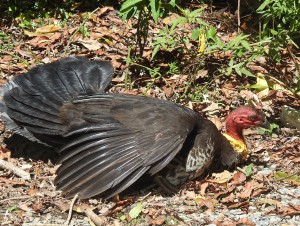Adding to a “life-list” (a list of all birds you have seen in the wild) can be fun, and can take you to many beautiful and exciting places and offer many hours in the clean air of seaside, desert or forest.
However, just ticking off a bird as seen and rushing off for the next “tick” can cause you to miss out on a lot of enjoyable experiences that give you a much deeper understanding of natural ecosystems.
Birds are not just pretty objects that happen to move around. They are living creatures – quite extraordinary living creatures in fact, with a rather complicated anatomy associated with flight, better eyesight than humans, more intelligence than they’re often given credit for, with a great variety of social structures, and many kinds of ecological relationships with other species. Instead of the “stamp-collecting” approach to bird-watching, you can gain many insights into the life of birds and the ecosystem generally by quietly sitting and watching, even if it is a species you’ve seen many times before.

Male satin bowerbird offering a flower to the female: we watched this during a tour to O’Reilly’s Rainforest Retreat
One of the most fascinating to watch is the satin bowerbird during breeding season. The male is a few years old before he even tries to build a bower, and often takes a year or two to get it right before the female is sufficiently impressed. With only his bill for building, he lays down a platform of twigs and then constructs an avenue of twigs into which to attract the females (one at a time) for mating. To accentuate the blue sheen of his feathers he collects blue objects – quite a task originally to find enough feathers, flowers and berries of the right colour, but nowadays often including more readily available drinking straws, bottle tops and other such objects. He struts around, singing, dancing and rearranging twigs and decorations, and when a female arrives continues his song and dance, even sometimes carrying flowers or other gifts to her, before finally consummating their relationship. She then has to build her own nest and raise the kids while he attracts more females.
Female brush turkeys have it better: the male makes an enormous mound of leaves and keeps adjusting it to an appropriate temperature, as the energy originally stored by photosynthesis is released as heat as the leaves decompose. All the female needs to do is lay an egg in this every few days. You would be lucky to catch a visit by the females, but the males are often seen scratching more leaves onto their nests and chasing off intruders.
Keep an eye out for birds who follow other birds. When brush turkeys or other strong-footed birds are kicking the leaf litter around in their search for insects, smaller birds such as scrubwrens often hand around waiting for insects that escape the notice of the large forager. If you see a grey fantail, especially out of breeding season, it is very likely to be following a whistler, a treecreeper or some other species that is foraging in the leaves or under the bark, ready to use its tail to facilitate acrobatic manoeuvres to catch insects trying to escape through the air.
 You can also get to know the different calls of a species: territorial songs, the alarm calls and the contact calls between male and female or members of a feeding flock. You can hear different melodies piped by pied butcherbirds in different districts or listen for the highly complex call, complete with amazing mimicry, of the lyrebird. You can head out at night listening for the calls of owls, frogmouths and nightjars (and no, despite a popular myth that was even believed by Banjo Patterson, the frogmouth does NOT give the mopoke call: the boobook owl does that). You can try to tell the difference between two birds having a dispute or indulging in courtship (sometimes this is obvious, sometimes not).You can sit very quietly in the forest for 20 minutes or so, preferably dressed in greens and browns, to see whether any shy birds, which would be disturbed by footsteps, make an appearance.
You can also get to know the different calls of a species: territorial songs, the alarm calls and the contact calls between male and female or members of a feeding flock. You can hear different melodies piped by pied butcherbirds in different districts or listen for the highly complex call, complete with amazing mimicry, of the lyrebird. You can head out at night listening for the calls of owls, frogmouths and nightjars (and no, despite a popular myth that was even believed by Banjo Patterson, the frogmouth does NOT give the mopoke call: the boobook owl does that). You can try to tell the difference between two birds having a dispute or indulging in courtship (sometimes this is obvious, sometimes not).You can sit very quietly in the forest for 20 minutes or so, preferably dressed in greens and browns, to see whether any shy birds, which would be disturbed by footsteps, make an appearance.
Many birds depend on plants, but many plants also depend on birds. Take note of any birds feeding amongst flowers or fruits. Most of these will be playing a role as pollinators or seed dispersers, although a few damage the flower to reach the nectar without picking up any pollen, and some either avoid swallowing the seeds or, worse still for the plant, digest them.
You may not always understand what a bird is doing or why. Sometimes it becomes clear just by watching for a few minutes, or sometimes it is an intriguing observation that keeps you puzzled for some time. Maybe others have observed it, or maybe not. There are various Facebook pages and other websites where you can put a question to the group, e.g.: “has anyone seen a xxx do this? Any idea why?”
A final note: some avid life-listers get so carried away with their hobby they forget the welfare of the bird. The occasional recorded call in a seldom-traveled area may not bother birds too much, but when male territorial calls are repeatedly played to the same birds in a popular birding spot, especially during breeding season, it can waste a lot of a bird’s much-needed energy in defending his territory, with the potential of stressing it to the point where it shifts home, possibly to a less optimal habitat, or is so drained of energy it is more vulnerable to disease, parasites or predation. Waking up a diurnal bird at night or a nocturnal bird during the day can cause it to blunder off clumsily, possibly into danger. Getting too close to a nest may cause temporary desertion by the parent, exposing eggs or chicks to predation and uncomfortable or even dangerous temperatures. Different species and different individuals within the species have different temperaments, but it is better to err on the side of caution than risk the welfare of the individual bird or, in the case of rare species, their conservation chances for the future.






